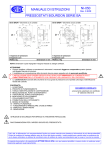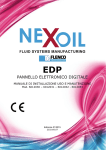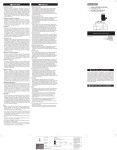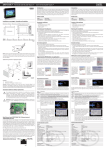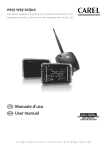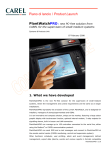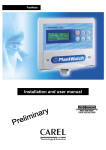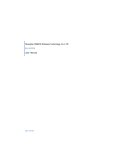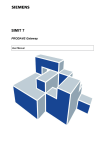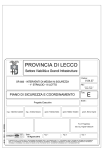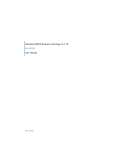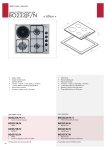Download +05_0530 • r.1.0 sonde Wireless
Transcript
cod. +050000530 rel. 1.1 - 02/03/05 IOR0002400 Ricevitore radio sonda / Wireless probe receiver Thank you for your choice. We trust you will be satisfied with your purchase. Vi ringraziamo per la scelta fatta, sicuri che sarete soddisfatti del vostro acquisto. Caratteristiche generali 115 102 Dimensioni / Dimensions Il ricevitore radio, dispositivo elettronico che fa parte del sistema “Wireless Probe”, permette di rilevare ed interpretare i dati provenienti dalle radio sonde e di convertirli nel formato supportato dai sistemi di supervisione CAREL. Per conoscerne il funzionamento e la modalità di configurazione fare riferimento al CD-Rom (cod. 6714320AXX); oppure si consulti l’indirizzo http://ksa.carel.com/carelksa/web/ita nell’area free download. Il prodotto può essere commercializzato in tutti i paesi della Comunità Europea tranne in Grecia, Bulgaria e Polonia. Per tutti gli altri paesi si verifichi la Normativa vigente in relazione alle caratteristiche radio. General features Nota importante: il ricevitore IOR0002400 non è un prodotto autonomo, per il suo funzionamento è indispensabile avere almeno un trasmettitore (cod. ASWT013000) e un sistema di supervisione come PlantVisor o PlantWatch. Mark well: the IOR0002400 receiver does not work independently but it needs at least a transmitter (code ASWT013000) and a supervision system such as PlantVisor or PlantWatch. Installazione del CD-Rom CD-Rom installation Requisiti minimi PC: Windows95/98/2000/XP, lettore CD-Rom PC minimum requirements: Windows95/98/2000/XP, CD-Rom drive Per eseguire l’installazione del software e dei manuali seguire le seguenti istruzioni: • inserire il CD-Rom nell’apposito supporto; • lanciare il file index.htm per conoscere il contenuto del CD-Rom. To install the software and the manuals, follow these instructions: • insert the CD-Rom in the CD-Rom drive; • open the index.htm file to see the CD-Rom contents. Caratteristiche tecniche Technical features Alimentazione: 2 1 GND + + - Potenza assorbita Caratteristiche radio Velocità trasmissione RS485 Conformità protocollo CAREL Max. num. sonde radio gestibili Condizioni di funzionamento Condizioni di stoccaggio 40 94 Connessioni Installazione • posizionare il ricevitore con il pressacavo verso il basso; • collegare l’alimentazione al morsetto 1, facendo attenzione alle polarità indicate, nel caso di alimentazione a tensione continua. ATTENZIONE: utilizzare un trasformatore o un alimentatore per ogni ricevitore, non è possibile condividere la stessa alimentazione per più macchine; • collegare la rete RS485 al morsetto 2. Installation • position the receiver with the cable gland pointing downwards; • connect the power supply to the terminal 1, paying attention to the shown polarity, in case of power supply under continuous voltage. WARNING: use a separate transformer or power supply for each receiver; the same power supply cannot be used for more than one unit; • connect the RS485 network to terminal 2. CAREL S.p.A. Via dell’Industria, 11 - 35020 Brugine - Padova (Italy) Tel. (+39) 0499716611 – Fax (+39) 0499716600 http://www.carel.com – e-mail: [email protected] The wireless probe receiver is an electronic device, part of the “Wireless probe" system; it acquires and interprets the data and converts them into CAREL supervisor-supported format. For its working and configuration mode refer to the CD-Rom (code 6714320AXX); or consult http://ksa.carel.com/carelksa/web/eng in the free download area. The product can be sold in all European Union countries, except for Greece, Bulgaria and Poland. For all the other contries check the standards in force in connection with the radio characteristics Montaggio: Visualizzazione/Configurazione Grado di protezione Classific. secondo la protezione contro le scosse elettiche Inquinamento ambientale PTI dei materiali di isolamento Periodo delle sollecitazioni elettriche delle parti isolanti Categoria di resistenza al calore e al fuoco Immunità contro le sovratens. Classe e struttura del software Smaltimento 24Vac ±10% 50/60Hz 2VA (trasformat. di sicurezza Classe II) 24 Vdc ±10% 1W (max) frequenza RX: 869,850MHz; Modulazione: FSK 19200 Kb/s, 2 bit stop ver. 3.0 e succ. 20 - range di temperatura: -20T55°C - range umidità: <80% U.R. non condens. - range di temperatura: -20T70°C - range umidità: <80% U.R. non condens. - morsetti a vite per alimentaz.: cavi sez. max. 2,5 mm2 - morsetto a vite per alimentazione LAN 485: cavi sez. max. 2,5 mm2 a muro tramite viti. lettura e scrittura parametri via RS485 di supervisione tramite programma dedicato. IP40 integrabili in apparecchiature di Classe I e II normale 250 V lungo categoria D (per scatola e coperchio) categoria 1 classe A seguire le norme locali per lo smaltim. di materiale elettrico Input: Absorbed power Radio features Transmission speed of RS485 Compliance to CAREL protocol Manageable wireless probes max. nr. Working conditions Storage conditions Connections Mounting: Display / Configuration Protection index: Classif. according to protection against electric shocks Environmental pollution PTI of insulating materials Period of electrical stress across insulating parts Category of heat and fire resistance: Immunity against voltage surges Software class and structure Disposal 24Vac ±10% 50/60Hz 2VA (with Class II safety transformer) 24 Vdc ±10% 1W (max) RX frequency: 869,850MHz; Modulation: FSK 19200 Kb/s, 2 bit stop ver. 3.0 ff. 20 - temperature range: -20T55°C - humidity range: <80% U.R. non condensing - temperature range: -20T70°C - humidity range: <80% U.R. non condensing - feed screw clamps.: cable max. sect. 2,5 mm2 - feed screw clamps LAN 485: cable max. sect. 2,5 mm2 wall, with screws. Parameter reading and writing via supervision RS485 through dedicated programme. IP40 to be integrated in Class I or II devices normal 250 V Long category D (for both case and cover) category 1 class A follow local laws to dispose electrical goods CAREL si riserva la possibilità di apportare modifiche o cambiamenti ai propri prodotti senza alcun preavviso. CAREL reserves the right to modify the features of its products without prior notice. cod. +050000530 rel. 1.1 - 02/03/05 cod. +050000530 rel. 1.1 - 02/03/05 ASWT013000 Trasmettitore radio sonda / Wireless probe transmitter Vi ringraziamo per la scelta fatta, sicuri che sarete soddisfatti del vostro acquisto. Dimensioni / Dimensions 102 115 Caratteristiche generali General features Il trasmettitore radio, dispositivo elettronico che fa parte del sistema “Wireless probe”, permette di acquisire i dati provenienti dalle sonde di temperatura, gli stati “ON/OFF” degli interruttori collegati ai suoi ingressi e di trasmetterli al ricevitore. Per conoscerne il funzionamento fare riferimento al manuale tecnico contenuto nel CD-Rom (cod. 6714320AXX), oppure si consulti l’indirizzo http://ksa.carel.com/carelksa/web/ita nell’area free download. Il prodotto può essere commercializzato in tutti i paesi della Comunità Europea tranne in Grecia, Bulgaria e Polonia. Per tutti gli altri paesi si verifichi la Normativa vigente in relazione alle caratteristiche radio Le sonde di temperatura non sono fornite nell’imballo, è possibile scegliere quelle di tipo NTC più adatte tra i prodotti CAREL. The wireless probe transmitter is an electronic device, part of the “Wireless probe" system; it acquires the data of the temperature probes and reads the “ON/OFF” statuses of the switches connected to its inputs, and transmits them to the receiver. For its working, refer to the technical manual in the CD-Rom of the receiver (code 6714320AXX), or consult http://ksa.carel.com/carelksa/web/eng in the free download area. The product can be sold in all European Union countries, except for Greece, Bulgaria and Poland. For all the other contries check the standards in force in connection with the radio characteristics The temperature probes are not supplied in the packaging; the more suitable NTC probes from the CAREL range can be chosen. Nota importante: il trasmettitore ASWT013000 non è un prodotto autonomo, per il suo funzionamento è indispensabile avere almeno un ricevitore (cod. IOR0002400) e un sistema di supervisione come PlantVisor o PlantWatch. Mark well: the ASWT013000 transmitter does not work independently but it needs at least a receiver (code IOR0002400) and a CAREL supervision system such as PlantVisor or PlantWatch. Caratteristiche tecniche Technical features Alimentazione Potenza Assorbita Durata batteria in condizioni normali di funzionamento Caratteristiche radio Condizioni di funzionamento Condizioni di stoccaggio 40 Risoluzione ingressi di temper. Connessioni: 94 1 * Installazione 2 3 4 * • collegare la batteria tramite l’apposito connettore; • posizionare il trasmettitore con il pressacavo verso il basso; • eseguire i collegamenti elettrici come mostrato in figura. Morsetti: 1 interruttore 1; 2 interruttore 2/defrost; 3 ingresso temperatura 2; 4 ingresso temperatura 1. * in funzione della programmazione software Installation Terminals: • connect the battery using the special connector; • position the transmitter with the cable gland pointing downwards; • make the electrical connections as shown in the figure. 1 2 3 4 * switch 1; switch 2/defrost; temperature input 2; temperature input 1 according to the software programming CAREL S.p.A. Via dell’Industria, 11 - 35020 Brugine - Padova (Italy) Tel. (+39) 0499716611 – Fax (+39) 0499716600 http://www.carel.com – e-mail: [email protected] Thank you for your choice. We trust you will be satisfied with your purchase. Montaggio Visualizzazione / Configurazione Grado di protezione contenitore Classificaz. secondo la protezione contro le scosse elettriche Inquinamento ambientale PTI dei materiali di isolamento Periodo delle sollecitazioni elettriche delle parti isolanti Categoria di resistenza al calore e al fuoco Immunità contro le sovratensioni Classe e struttura del software Smaltimento batteria al LItio SANYO CR17335-C (IEC TYPECR17338) 130 mW (max) 5 anni. CAREL non si assume alcuna responsabilità per la durata indicata) frequenza RX: 869,850 MHz modulazione: FSK potenza irradiata: 5mW ERP - range di temperatura: -20T55°C - range umidità: <80% U.R. non condensante - range di temperatura: -20T70°C - range umidità: <80% U.R. non condensante ± 0,5 °C - morsetti a vite per interruttori ON/OFF: cavi sez. max. 2,5 mm2 - morsetti a vite per sonde di temp.: cavi sez. max. 2,5 mm2 si consiglia l’utilizzo di morsetti a bassa resistenza o con deposito in oro a muro tramite viti. lettura e scrittura parametri attraverso ricevitore radio CAREL IP40 integrabili in apparecchiature di Classe I e II normale 250 V lungo categoria D (per scatola e coperchio) categoria 1 classe A seguire le norme locali per lo smaltimento di materiale elettrico Input Absorbed power Battery life in normal working conditions Radio features Working conditions Storage conditions Temperature input resolution Connections: gold-plated contacts Mounting Display / Configuration Case protection index Classif. according to protection against electric shocks Environmental pollution PTI of insulating materials Period of electrical stress across insulating parts Categ. of heat and fire resistance Immunity against voltage surges Software class and structure Disposal SANYO CR17335-C lithium battery (IEC TYPE CR17338) 130 mW (max) 5 years RX frequency: 869,850MHz modulation: FSK irradiated power: 5mW ERP - temperature range: -20T55°C - humidity range: <80% U.R. non-condensing - temperature range: -20T70°C - humidity range: <80% U.R. non-condensing ± 0,5 °C - screw clamps for ON/OFF switches: cables max. sect. 2,5 mm2 - screw clamps for temperature probes: cables max. sect. 2,5 mm2 we recommend the use of terminals with low-resistance wall, with screws. Parameter reading and writing through CAREL radio receiver IP40 to be integrated in Class I or II devices normal 250 V long category D (for both case and cover) category 1 class A follow local laws to dispose electrical goods CAREL si riserva la possibilità di apportare modifiche o cambiamenti ai propri prodotti senza alcun preavviso. CAREL reserves the right to modify the features of its products without prior notice. cod. +050000530 rel. 1.1 - 02/03/05


